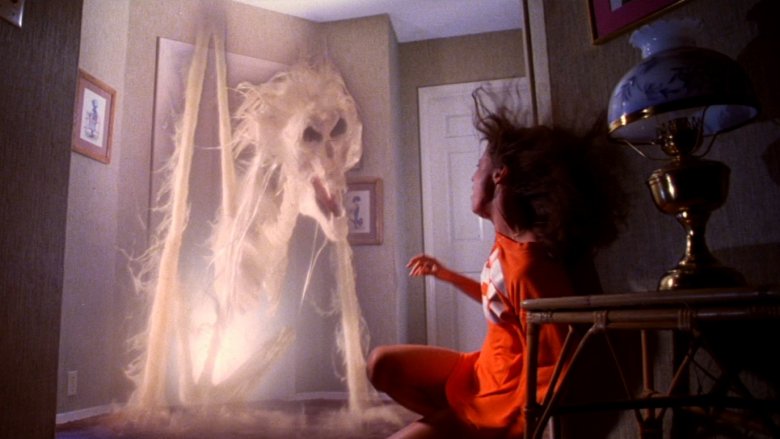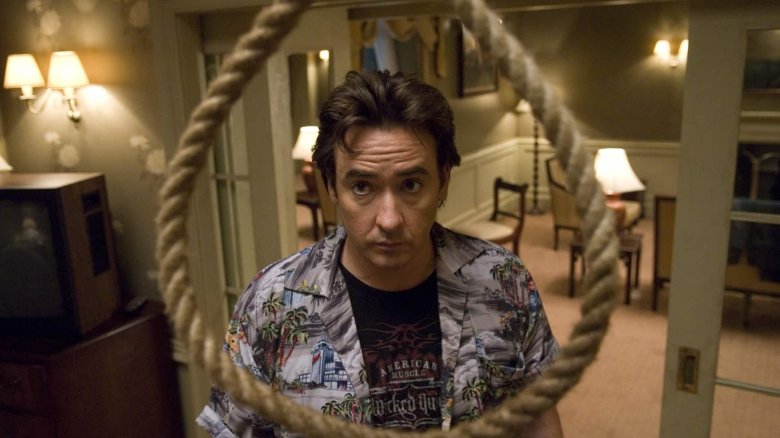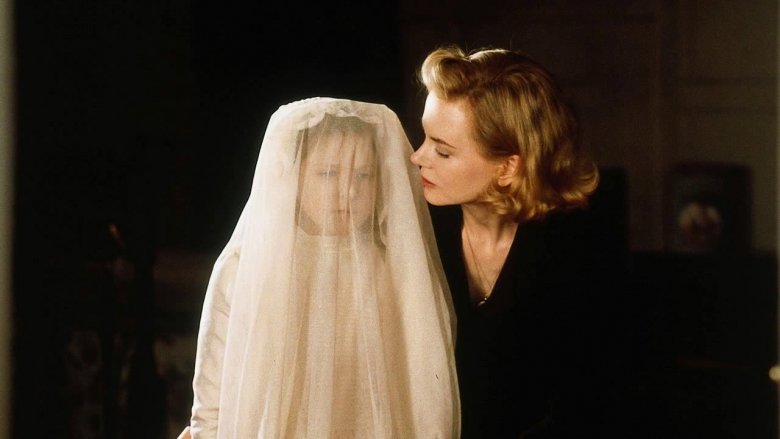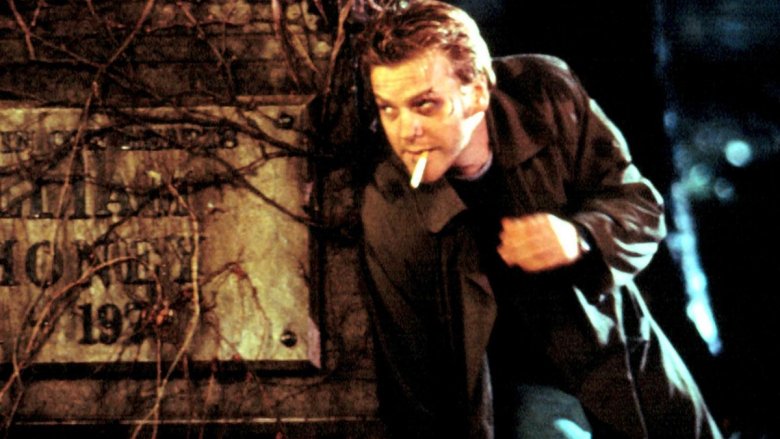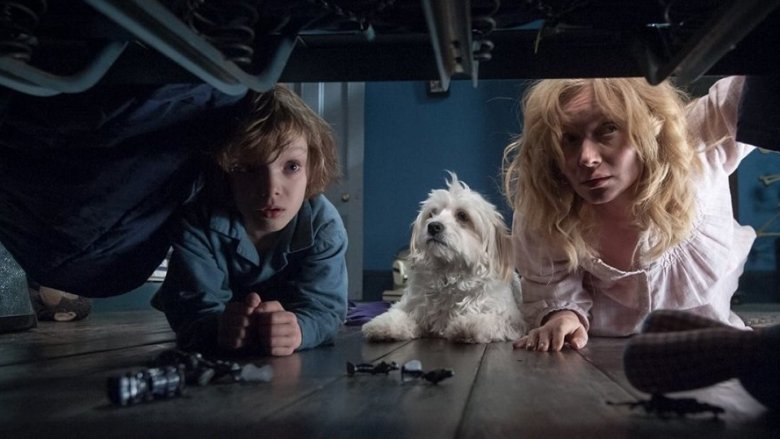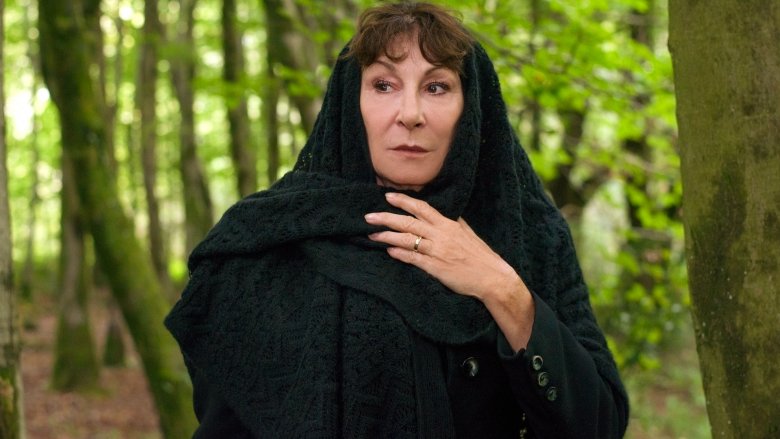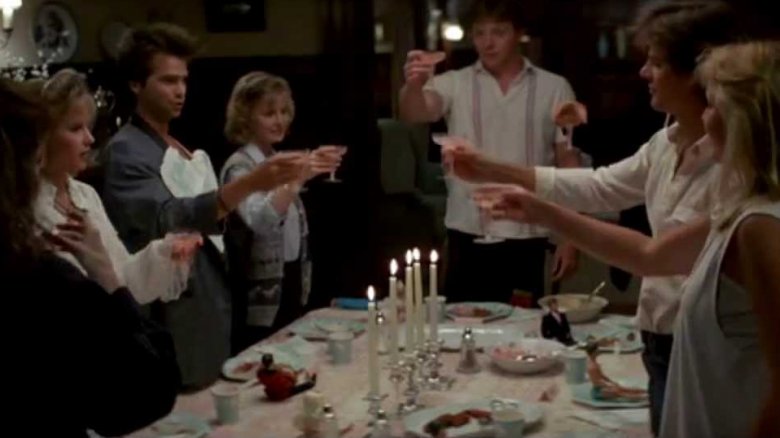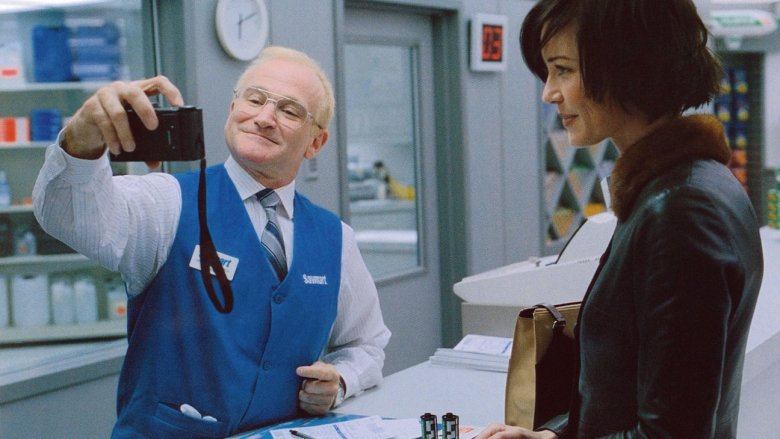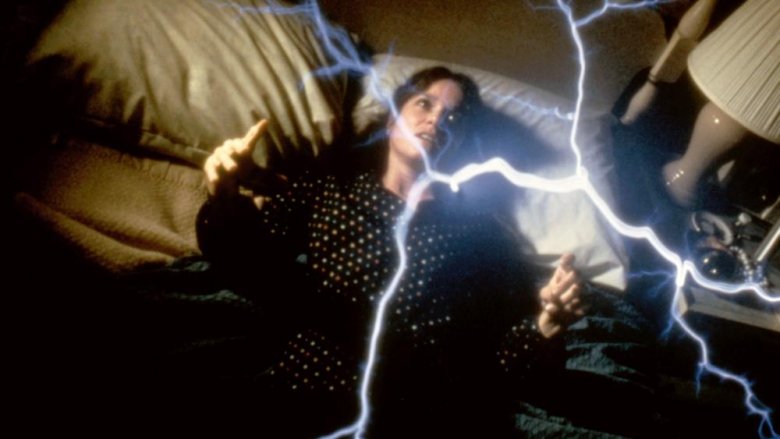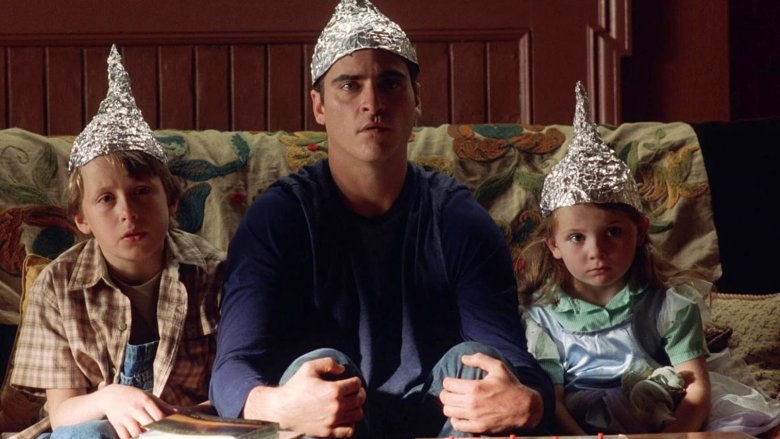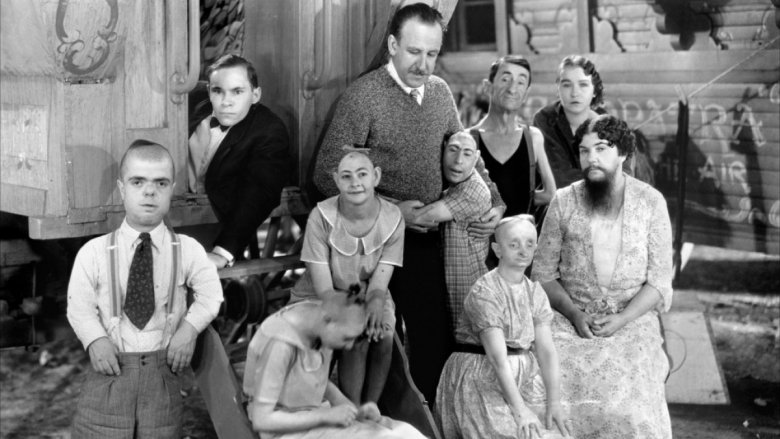The Scariest Horror Movies Where Nobody Actually Dies
The wonderful thing about the horror genre is the breadth of styles that it can encompass. Everyone is afraid of something, and tapping into those dark fears can lead to some amazingly scary movies.
While horror movies often come with a sizable body count, there's more to the larger genre of horror than just a well-stocked kill list. There are plenty of things that go bump in the night that are scarier than murder. From ghostly apparitions that haunt family trauma to the invasive knowledge of someone watching you and knowing your innermost secrets, here are the scariest horror movies where no one actually dies onscreen. (Spoilers!)
Poltergeist (1982)
"They're here!" announces little girl Carol Anne in one of the most terrifying ghost story movies of all time – Poltergeist. Directed by Tobe Hooper (although there's a long-running discussion about who truly directed the film) and produced by Steven Spielberg, Poltergeist has been parodied, referenced, and even remade, but nothing can detract from the genuinely frightening visuals and invasive horror of the film. The film follows a middle-class family whose home was built over a Native American burial ground. As you might expect, assorted hauntings follow.
Although there's a brief kidnapping to the spirit realm, and a truly upsetting nighttime swim, no one actually dies in Poltergeist. The Freeling family is ultimately able to escape with lives intact, although they lose both their home and the safe sanctuary that their home represented. Some would say that that's even scarier than that truly horrific clown doll.
1408 (2007)
Based on one of Stephen King's short stories, 1408 has a simple hook that's hard to beat: Skeptic Mike Enslin (John Cusack) rents a haunted hotel room after the death of his young daughter to prove that ghosts don't exist. Since this is a horror movie and not a documentary, you can pretty much guess how it goes for Mike. Still, the bare-bones plot description undersells the mind-bending surrealist horror that 1408 showcases. The horror in the film doesn't come from Mike's fear of the ghosts but from his experiences within a twisted reality wherein he can't trust his senses or even himself.
In fact, despite the film's emphasis on Mike's dead daughter, and the room's consistent encouragement for Mike to kill himself, Mike lives through the final credits. At least, in the theatrical release. The unused alternate ending shows Mike killing himself to destroy the room. A grim finale for a movie about a father struggling to overcome his grief.
The Others (2001)
Part of the reason that death is such an easy way to elicit fear in an audience is the mystery of it all. The existential terror of being subjected to an existence of which you are entirely ignorant is a scary prospect. The Others is a horror movie ostensibly about a haunted house, but the real terror of the movie is in being trapped and battered by forces you cannot comprehend. In fact, "the other side" is as impossible to see coming as the twist of The Others.
As it turns out, in the film, the family of three living in a house in fear of ghosts are themselves the ghosts. What they believed to be the ghosts were, in fact, the new owners of the house struggling to understand what to do about their haunted home. It's a twist that flips horror movie conventions on their heads, showcasing how horrific a ghost story can be even for the ghost. (And, if you look back at the film, you'll realize, from playing ball on the stairs to drawing
the shades, the ghostly residents were actually fulfilling all of the stereotypical things ghosts usually do in haunted houses.) Plus, since the main family were actually ghosts the whole time, no one actually dies in the movie itself.
Flatliners (1990)
Flatliners has one of the greatest concepts in horror movie history: A group of med students tries to explore the afterlife by dying (or "flatlining") before getting shocked back to life. There's a deep vein of psychological horror in exploring how a near-death experience would affect someone's personality and Flatliners manages to get a solid amount of mileage out of the different perceptions of a near-death experience. Later, when the characters start experiencing hallucinations, the film really gets scary. The idea that you can't ever escape death is a potent one. Still, despite a few near misses, no one actually dies in Flatliners. All of the main characters ultimately live through their flatlining experience.
The Babadook (2014)
In horror, a great character design can go a long way toward eliciting terror in the audience. The eponymous monster in The Babadook definitely fits the bill by looking like a cross between a shadow puppet and a cockroach. The design is obviously based on early twentieth-century Gothic films. The film itself manages to infuse its obvious influences with powerful performances and a tight script that keeps audiences rapt with dread.
Like all the best horror movies, The Babadook lets the central monster become symbolic for any number of horrific real-life experiences, experiences of trauma, loneliness, and mental illness. The symbolic weight of the film doesn't drag the film down into maudlin subtext though; you can enjoy it as a simple movie about a single mother trying to keep her son safe and her life together. In spite of its frights, no person actually dies in The Babadook, although viewers squeamish about watching family pets die should steer clear.
The Watcher in the Woods (1980)
Don't let the Disney logo on this one fool you; The Watcher in the Woods is an incredibly frightening movie. Following two young girls as they move into a rural town in New England, the film trades on fairy tale tropes and storytelling to great effect. It makes sense that The Watcher in the Woods would be inspired by fairy tales (the movie's relationship to Disney notwithstanding); they touch on fundamental childhood fears. Nothing scares us like the things that scared us as children, and what child isn't afraid of a thing lurking in the woods stealing wayward children?
There is a creeping dread throughout the movie, but the characters in The Watcher in the Woods escape unscathed, even the girl whose off-screen disappearance fuels the plot of the film remains unhurt. The climax itself actually revolves around the power of friendship and the importance of empathy.
April Fool's Day (1986)
April Fool's Day might be the only slasher film on this list, since a sub-genre focused on a group of victims being killed in consecutive order makes it difficult to have examples where no one actually dies. The film follows a group of friends who go on a weekend trip full of pranks and practical jokes to celebrate April Fool's Day (although that might be the most fantastical concept in the movie itself).
From there, the plot sprints through evil twins, shocking deaths, and a strangely mobile jack-in-the-box in a phantasmagoria of blood and gore. Despite the corpses and blood, no one actually dies in the film. As it turns out, each character who was "killed" was actually in on the joke, helping to craft a specialized horror resort. Even a fake out finale ends up being nothing more than a practical joke, making this the bloodiest casualty-free movie we can think of.
One Hour Photo (2002)
Robin Williams is best remembered for his comedic work, but he's absolutely chilling as Seymour Parrish — a voyeuristic stalker with a decidedly on-the-nose name ("see-more perish") — in One Hour Photo. The film follows Seymour as he becomes obsessed with the Yorkin family while developing their photos. When he discovers the family isn't as perfect as he had believed, he escalates his voyeuristic habits by stalking and even threatening them at gunpoint.
The movie works in the horror/thriller genre precisely because of Seymour, the kind of person you immediately forget about after you leave your local store — his private life and his access to yours are obscured by his job. The Yorkin family might not care about Seymour, but he cares about them to a frightening degree.
Still, despite his creepy behavior, Seymour doesn't actually kill anyone in the film. He's safely apprehended by the police while the Yorkin family gets to find another photo developer to print their family photos.
The Entity (1983)
It's often easy for horror movies to end a film before actually addressing the sizable body count left in their wake. The difficulty of the survivors' recovery, those moments after the killer sinks into the lake and the police show up, those are often left to an audience's imagination. By avoiding those difficult questions, a horror movie can end on a slightly uplifting note.
The Entity features a story that is almost entirely concerned with the aftermath of horror, following a woman brutally attacked and raped by a poltergeist — one which continues to haunt and torture her and her family. Even after the film's climax involving a trap for the spirit, the happy ending is only that she is able to better survive these awful attacks. The film drips with a convincing grotesqueness that's only magnified by The Entity's opening assertion that it's based on a true story and that the real woman still suffers these attacks. Even without a body count, The Entity is deeply unsettling.
Signs (2002)
M. Night Shyamalan might have gotten a bit of a bad reputation for cheesy, but at one point in time, he was the king of the plot twist, working with tightly written scripts and charismatic actors. While his later work would receive many negative critiques, Signs remains one of his bright spots. It might not be The Sixth Sense, but it's a surprisingly effective horror movie. The film follows a family in rural Pennsylvania whose grief at the death of their matriarch is interrupted by an alien invasion. The horror in Signs is restrained, blending the family's questioning faith with the arrival of alien conquerors so seamlessly that some fans have theorized that the aliens are actually demons.
In keeping with the film's theme of believing in a benevolent God and organized universe, no one dies in Signs. Whether the monsters in the movie are aliens or demons, they're equally ineffective at killing anyone in the film.
Freaks (1932)
One of the most infamous movies ever made, Freaks dwells in that unique pantheon of not-quite-classic movies where nearly everyone has heard of it but few people have actually seen it. Which makes sense considering it is a 1932 pre-code horror movie — "pre-code" referring to the infamous Hays Code that forbade movies from featuring a litany of subjects, from homosexuality to sexual relations outside marriage. The Hays Code put a metaphorical stake in horror movies' hearts, rendering them tame and often toothless.
Freaks is anything but toothless. Directed by Tod Browning (of Dracula fame), the film follows a manipulative female acrobat whose plan to marry and kill a wealthy dwarf in the circus leads to one of the most grisly endings in film history. Freaks was so horrific on its first showing that one woman claimed that it caused her to miscarry. Even after copious cuts, the film premiered and still horrified audiences. Nevertheless, the real horror of the film isn't the physically deformed members of the circus troupe (or even the grisly results of their revenge), but the unending fountain of human cruelty that even the most beautiful of performers are capable of.
